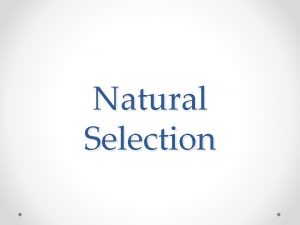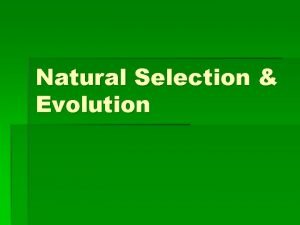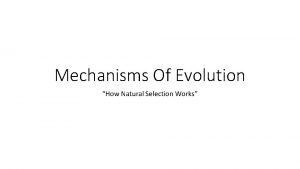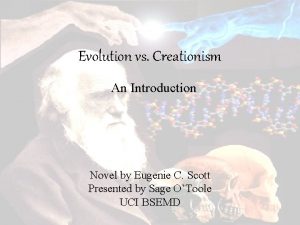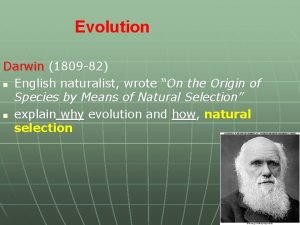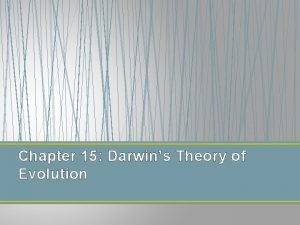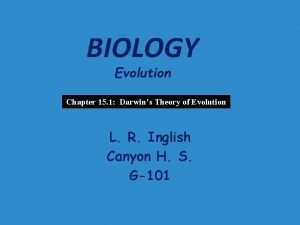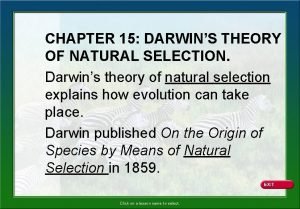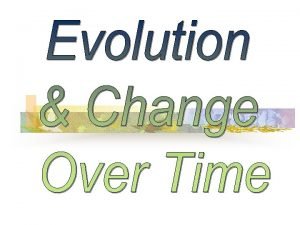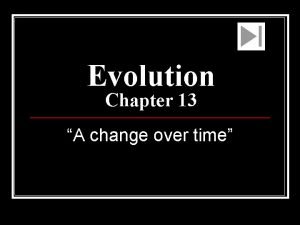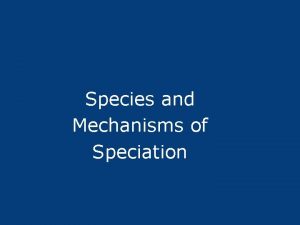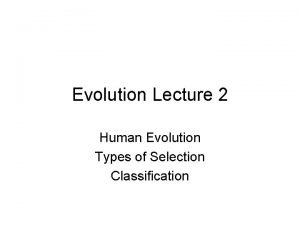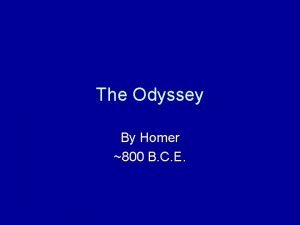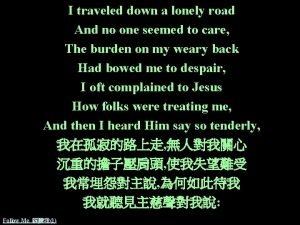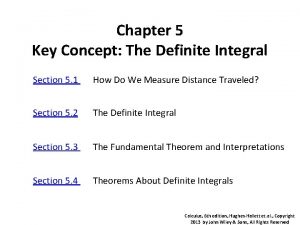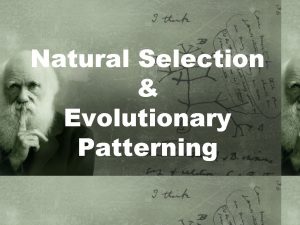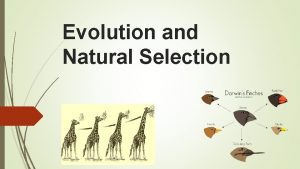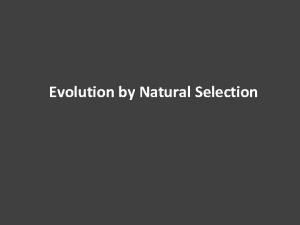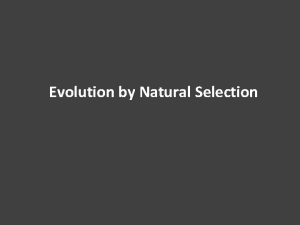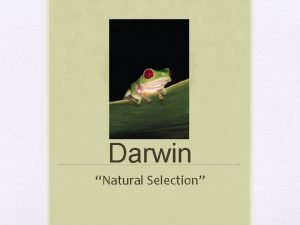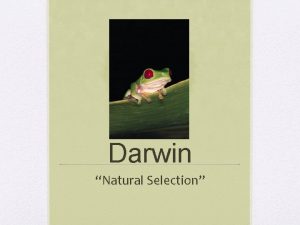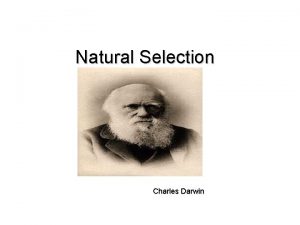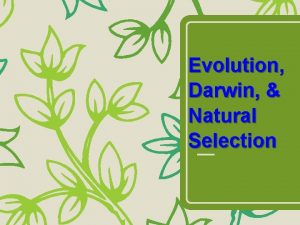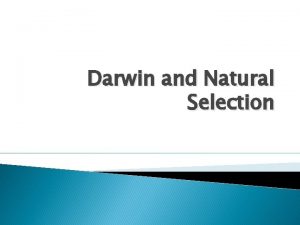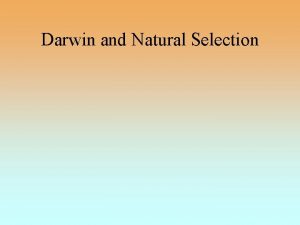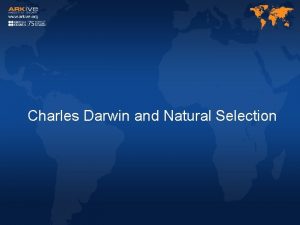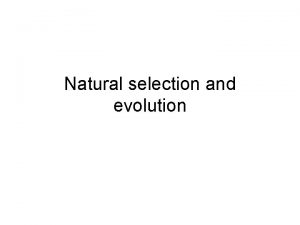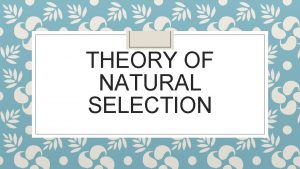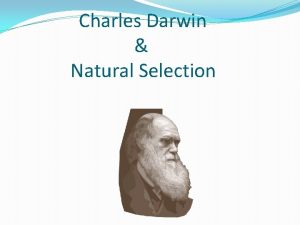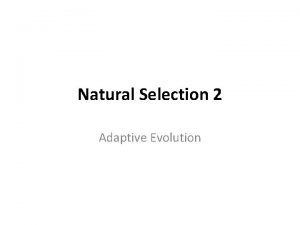Evolution Darwin and Natural Selection Darwin traveled around





























- Slides: 29

Evolution: Darwin and Natural Selection

Darwin traveled around the world on the HMS Beagle. He went to collect plant and animal specimens.

Three Observations Species vary globally Species vary locally Species vary over time

Galapagos Tortoises Darwin saw differences among the giant land tortoises that inhabit the islands The shape of the tortoises’ shells corresponds to different habitats.

Isabela Island has high peaks, is rainy, and has abundant vegetation that is close to the ground. A tortoise from Isabela Island has a dome-shaped shell and short neck.

Hood Island, in contrast, is flat, dry, and has sparse vegetation. A long neck and a shell that is curved and open around the neck and legs allow the Hood Island tortoise to reach sparse, high vegetation.

Species Vary Locally In addition, Darwin noticed several types of small brown birds on the islands with beaks of different shapes.

Darwin’s Question The observations being made in Geology caused Darwin to ask himself the question, – If Earth can change over time, can life change over time?

Natural Selection Tying together all of his observations, Darwin presented his idea of natural selection. Natural selection is the process by which organisms with variations most suited to their local environment survive and leave more offspring.

Natural Selection In natural selection, the environment determines fitness Fitness is measured by reproduction!

Fitness – describes how well an organism can survive and reproduce in its environment.

Natural Selection Well-adapted individuals survive and reproduce. From generation to generation, populations continue to change as they become better adapted, or as their environment changes.

Natural Selection Natural selection acts only on inherited traits because those are the only characteristics that parents can pass on to their offspring.

True or False: Evolutionary fitness is measured by amount of offspring produced. A) True B) False

Natural Selection is determined by: A) An organism’s ability to change its DNA B) An organism’s environment C) An organism’s mate

Natural Selection occurs on: A) Acquired traits B) Inherited traits

Natural Selection Natural selection occurs in any situation in which: – More individuals are born than can survive (the struggle for existence) – There is natural heritable variation (variation and adaptation) – There is variable fitness among individuals (survival of the fittest).

Natural Selection This hypothetical population of grasshoppers changes over time as a result of natural selection. Grasshoppers can lay more than 200 eggs at a time, but only a small fraction of these offspring survive to reproduce.

Natural Selection In this population of grasshoppers, heritable variation includes yellow and green body color. Green color is an adaptation: The green grasshoppers blend into their environment and so are less visible to predators.

Natural Selection Because their color serves as a camouflage adaptation, green grasshoppers have higher fitness and so survive and reproduce more often than yellow grasshoppers do.

Natural Selection Green grasshoppers become more common than yellow grasshoppers in this population over time.

What do you think would happen to the grasshopper population if there were several years of drought?

Each of the following is a condition necessary for natural selection to occur EXCEPT A) more offspring are born than can survive. B) population size is very large. C) fitness varies among individuals. D) there is heritable variation among members of the population.

Natural Selection Natural selection does not make organisms “better. ” Adaptations don’t have to be perfect—just good enough to enable an organism to pass its genes to the next generation.

Natural Selection Natural selection also doesn’t move in a fixed direction. – There is no one, perfect way of doing something. Natural selection is simply a process that enables organisms to survive and reproduce in a local environment.

Natural Selection If local environmental conditions change, some traits that were once adaptive may no longer be useful, and different traits may become adaptive. If environmental conditions change faster than a species can adapt to those changes, the species may become extinct.

True or False: Natural Selection is directional. A) True B) False

True or False: Natural Selection is purposeful. A) True B) False

According to Darwin’s theory of natural selection, individuals who survive are the ones best adapted for their environment. Their survival is due to the A) possession of adaptations developed through use. B) possession of inherited adaptations that maximize fitness. C) lack of competition within the species. D) choices made by plant and animal breeders.
 Natural selection
Natural selection 3 types of natural selection
3 types of natural selection Mechanisms of evolution
Mechanisms of evolution Natural selection vs evolution
Natural selection vs evolution Similarities
Similarities Natural selection vs artificial selection
Natural selection vs artificial selection Difference between continuous and discontinuous variation
Difference between continuous and discontinuous variation Directional selection
Directional selection Natural selection vs artificial selection
Natural selection vs artificial selection H
H Chapter 15 darwin's theory of evolution section 15-1
Chapter 15 darwin's theory of evolution section 15-1 Chapter 17 darwins theory of evolution
Chapter 17 darwins theory of evolution Chapter 15 darwin's theory of evolution section 15-1
Chapter 15 darwin's theory of evolution section 15-1 Chapter 15 darwin's theory of evolution section review 15-1
Chapter 15 darwin's theory of evolution section review 15-1 Charles darwin theory of evolution
Charles darwin theory of evolution Chapter 15 darwin's theory of evolution
Chapter 15 darwin's theory of evolution Examples of homologous structures
Examples of homologous structures Darwin's theory of evolution
Darwin's theory of evolution Example of what goes around comes around
Example of what goes around comes around Martin luther king of hinduism
Martin luther king of hinduism A boat traveled 336 miles downstream and back
A boat traveled 336 miles downstream and back Two way selection and multiway selection in c
Two way selection and multiway selection in c Multiway selection in c
Multiway selection in c Mass selection
Mass selection Speciation definition biology
Speciation definition biology Evolution types
Evolution types Epic simile
Epic simile The amount of speed per unit of time
The amount of speed per unit of time I travel down a lonely road
I travel down a lonely road Distance traveled calculus
Distance traveled calculus
